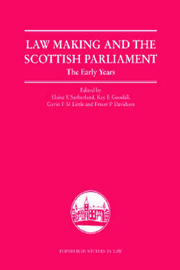Book contents
- Frontmatter
- Contents
- Preface
- List of Contributors
- Table of Cases
- Table of Westminster Statutes
- Table of Scottish Parliament Statutes
- Table of Westminster Statutory Instruments
- Table of Scottish Statutory Instruments
- THE SCOTTISH PARLIAMENT – ITS GENESIS AND OPERATION
- RIGHTS AND SOCIETY
- PUBLIC ADMINISTRATION AND SERVICES
- 7 Local Government
- 8 Housing
- 9 Education: Could Do Better
- JUSTICE AND LEGAL SYSTEM
- ECONOMY AND ENVIRONMENT
- Index
8 - Housing
from PUBLIC ADMINISTRATION AND SERVICES
Published online by Cambridge University Press: 05 September 2013
- Frontmatter
- Contents
- Preface
- List of Contributors
- Table of Cases
- Table of Westminster Statutes
- Table of Scottish Parliament Statutes
- Table of Westminster Statutory Instruments
- Table of Scottish Statutory Instruments
- THE SCOTTISH PARLIAMENT – ITS GENESIS AND OPERATION
- RIGHTS AND SOCIETY
- PUBLIC ADMINISTRATION AND SERVICES
- 7 Local Government
- 8 Housing
- 9 Education: Could Do Better
- JUSTICE AND LEGAL SYSTEM
- ECONOMY AND ENVIRONMENT
- Index
Summary
INTRODUCTION
Housing has been a major feature of the first ten years of the Scottish Parliament. Legislation in relation to housing has been a major part of the work of the Holyrood legislature. there have been no fewer than three major pieces of legislation focusing solely on housing, as well as housing featuring significantly in three other Acts. Indeed, one of the first pieces of legislation to reach the statute books from the new Scottish Parliament was the Housing (Scotland) Act 2001 and, at the time of writing, a Housing (Scotland) Act is likely to be passed in 2010. Looking, then, at the overall picture of the law, policy and economics of housing in this era, it is possible to make some kind of initial judgment on the first decade of housing under devolution. In crude terms, the lot of those in Scotland who are homeless, in poor-quality housing or suffering from absentee landlords is probably better than their equivalents in England and Wales over the first decade of the twenty-first century. However, the effectiveness of the changes continues to lie in the level of resources devoted to them and, just as in William Kelso's Paisley, what happens on the ground in the lives of badly housed or homeless citizens depends not on what powers are enshrined in statute but on whether financial resources make these provisions meaningful.
- Type
- Chapter
- Information
- Law Making and the Scottish ParliamentThe Early Years, pp. 141 - 156Publisher: Edinburgh University PressPrint publication year: 2011

